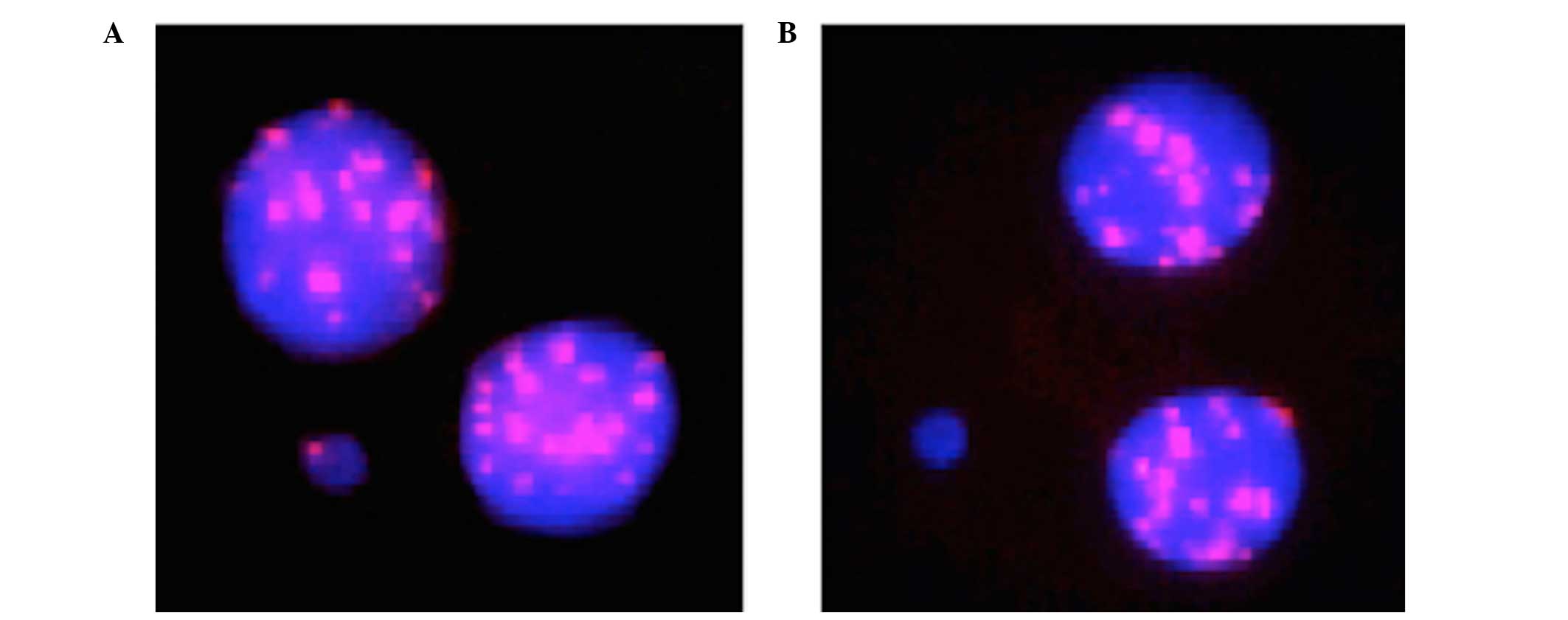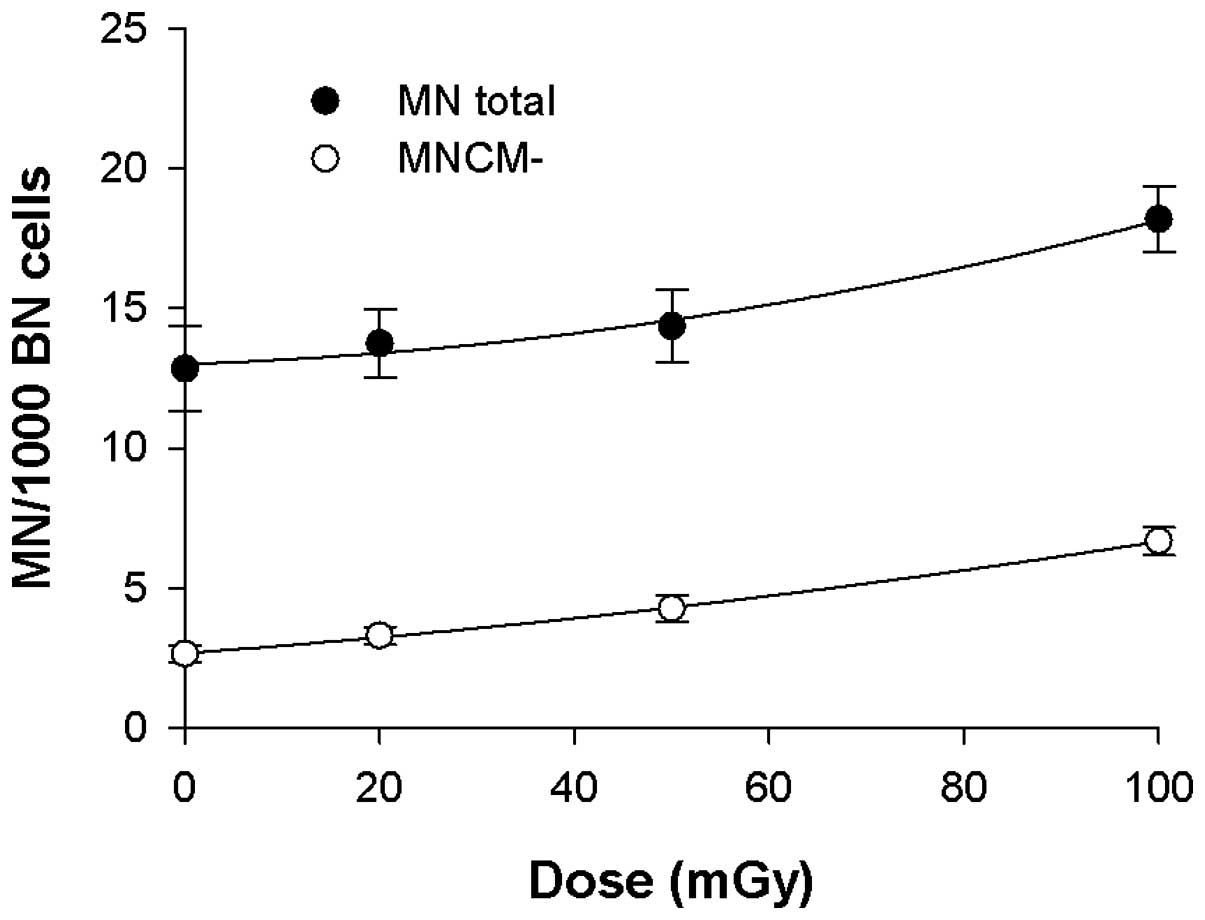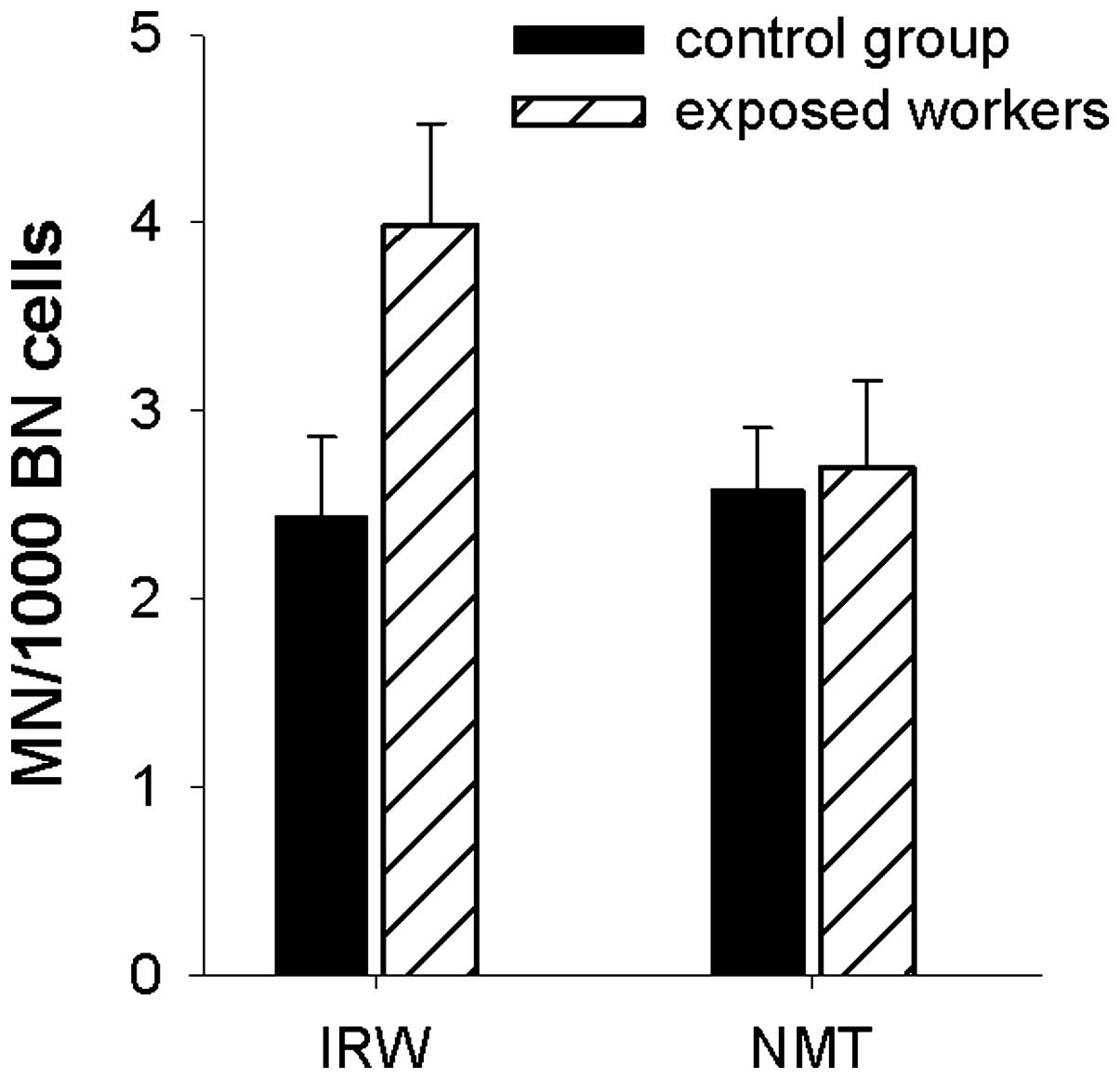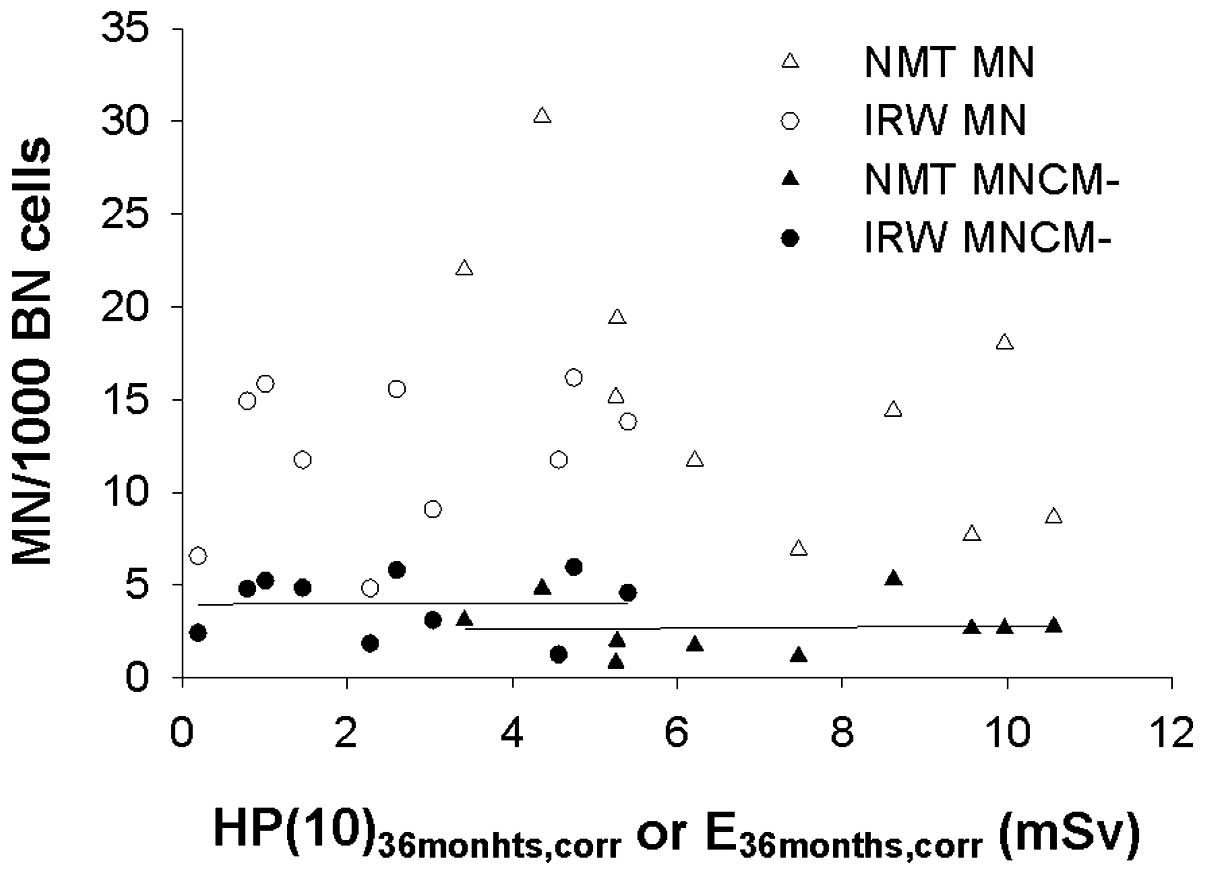|
1
|
Zakeri F and Hirobe T: A cytogenetic
approach to the effects of low levels of ionizing radiations on
occupationally exposed individuals. Eur J Radiol. 73:191–195. 2010.
View Article : Google Scholar
|
|
2
|
Ropolo M, Balia C, Roggieri P, Lodi V,
Nucci MC, Violante FS, Silingardi P, Colacci A and Bolognesi C: The
micronucleus assay as a biological dosimeter in hospital workers
exposed to low doses of ionizing radiation. Mutat Res. 747:7–13.
2012. View Article : Google Scholar : PubMed/NCBI
|
|
3
|
Martin CJ, Sutton DG, West CM and Wright
EG: The radio-biology/radiation protection interface in healthcare.
J Radiol Prot. 29:A1–A20. 2009. View Article : Google Scholar
|
|
4
|
Thierens H, Vral A, Morthier R, Aousalah B
and De Ridder L: Cytogenetic monitoring of hospital workers
occupationally exposed to ionizing radiation using the micronucleus
centromere assay. Mutagenesis. 15:245–249. 2000. View Article : Google Scholar : PubMed/NCBI
|
|
5
|
Cardoso RS, Takahashi-Hyodo S, Peitl P Jr,
Ghilardi-Neto T and Sakamoto-Hojo ET: Evaluation of chromosomal
aberrations, micronuclei and sister chromatid exchanges in hospital
workers chronically exposed to ionizing radiation. Teratog Carcinog
Mutagen. 21:431–439. 2001. View
Article : Google Scholar
|
|
6
|
Dias FL, Antunes LM, Rezende PA, Carvalho
FE, Silva CM, Matheus JM, Oliveira JV Jr, Lopes GP, Pereira GA and
Balarin MA: Cytogenetic analysis in lymphocytes from workers
occupationally exposed to low levels of ionizing radiation. Environ
Toxicol Pharmacol. 23:228–233. 2007. View Article : Google Scholar : PubMed/NCBI
|
|
7
|
Montoro A, Rodríguez P, Almonacid M,
Villaescusa JI, Verdú G, Caballín MR, Barrios L and Barquinero JF:
Biological dosimetry in a group of radiologists by the analysis of
dicentrics and trans-locations. Radiat Res. 164:612–617. 2005.
View Article : Google Scholar : PubMed/NCBI
|
|
8
|
International Atomic Energy Agency (IAEA):
Emergency Preparedness and Response Biodosimetry 2011: Cytogenetic
Dosimetry: Applications in preparedness for a response to radiation
emergencies. IAEA; Vienna, Austria: 2011
|
|
9
|
Baeyens A, Swanson R, Herd O, Ainsbury E,
Mabhengu T, Willem P, Thierens H, Slabbert JP and Vral A: A
semi-automated micronucleus-centromere assay to assess low-dose
radiation exposure in human lymphocytes. Int J Radiat Biol.
87:923–931. 2011. View Article : Google Scholar : PubMed/NCBI
|
|
10
|
Von Boetticher H, Lachmund J and Hoffmann
W: An analytic approach to double dosimetry algorithms in
occupational dosimetry using energy dependent organ dose conversion
coefficients. Health Phys. 99:800–805. 2010. View Article : Google Scholar : PubMed/NCBI
|
|
11
|
International Commission on Radiological
Protection (ICRP): The 2007 Recommendations of the International
Commission on Radiological Protection. ICRP publication 103, Ann
ICRP. 37:2–4. 2007.
|
|
12
|
Thierens H, De Ruyck K, Vral A, de Gelder
V, Whitehouse CA, Tawn EJ and Boesman I: Cytogenetic biodosimetry
of an accidental exposure of a radiological worker using multiple
assays. Radiat Prot Dosimetry. 113:408–414. 2005. View Article : Google Scholar : PubMed/NCBI
|
|
13
|
Willems P, August L, Slabbert J, Romm H,
Oestreicher U, Thierens H and Vral A: Automated micronucleus (MN)
scoring for population triage in case of large scale radiation
events. Int J Radiat Biol. 86:2–11. 2010. View Article : Google Scholar : PubMed/NCBI
|
|
14
|
Schunck C, Johannes T, Varga D, Lörch T
and Plesch A: New developments in automated cytogenetic imaging:
Unattended scoring of dicentric chromosomes, micronuclei, single
cell gel electrophoresis, and fluorescence signals. Cytogenet
Genome Res. 104:383–389. 2004. View Article : Google Scholar : PubMed/NCBI
|
|
15
|
Wojcik A, Kowalska M, Bouzyk E,
Buraczewska I, Kobialko G, Jarocewicz N and Szumiel I: Validation
of the micro-nucleus-centromere assay for biological dosimetry. Gen
Mol Biol. 23:1083–1085. 2000. View Article : Google Scholar
|
|
16
|
Pala FS, Alkaya F, Tabakcioglu K, Tokatli
F, Uzal C, Parlar S and Algünes C: The effects of micronuclei with
whole chromosome on biological dose estimation. Turkish J Biol.
32:283–290. 2008.
|
|
17
|
Romm H, Ainsbury E, Barnard S, Barrios L,
Barquinero JF, Beinke C, Deperas M, Gregoire E, Koivistoinen A,
Lindholm C, et al: Automatic scoring of dicentric chromosomes as a
tool in large scale radiation accidents. Mutat Res. 756:174–183.
2013. View Article : Google Scholar : PubMed/NCBI
|
|
18
|
Norppa H and Falck GC: What do human
micronuclei contain? Mutagenesis. 18:221–233. 2003. View Article : Google Scholar : PubMed/NCBI
|
|
19
|
Lindberg HK, Falck GC, Järventaus H and
Norppa H: Characterization of chromosomes and chromosomal fragments
in human lymphocyte micronuclei by telomeric and centromeric FISH.
Mutagenesis. 23:371–376. 2008. View Article : Google Scholar : PubMed/NCBI
|
|
20
|
Järvinen H, Buls N, Clerinx P, Jansen J,
Miljanić S, Nikodemová D, Ranogajec-Komor M and d'Errico F:
Overview of double dosimetry procedures for the determination of
the effective dose to the interventional radiology staff. Radiat
Prot Dosimetry. 129:333–339. 2008. View Article : Google Scholar : PubMed/NCBI
|
|
21
|
Järvinen H, Buls N, Clerinx P, Miljanic S,
Nikodemová D, Ranogajec-Komor M, Struelens L and d'Errico F:
Comparison of double dosimetry algorithms for estimating the
effective dose in occupational dosimetry of interventional
radiology staff. Radiat Prot Dosimetry. 131:80–86. 2008. View Article : Google Scholar : PubMed/NCBI
|


















